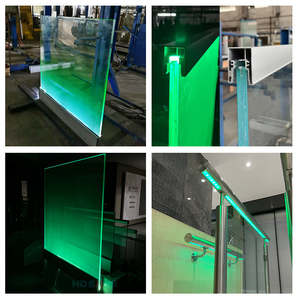
All categories
Featured selections
Trade Assurance
Buyer Central
Help Center
Get the app
Become a supplier

(8 products available)





















































Tree branch stair railings are exactly what they sound like: stair rails made from tree branches. Using tree branches as stair rails is a unique and creative way to incorporate nature into home design. It's important to note that tree branch stair rails can provide a rustic, natural look.
Spiral Handrails
Spiral Handrails are a perfect way to use branches with a natural curvature. Curved branches provide an organic grip area for the hand. The handrail can be mounted on straight metal spindles to follow the spiral staircase's shape. This design keeps the wood's natural shape and texture while securely guiding people up the spirals.
Straight Metal Balusters
Another option is using straight metal balusters to support a handrail made from a tree branch. The straight metal posts provide a modern contrast to the organic wood. They also give extra stability to straight or gently curving handrails crafted from branches. This pairing of materials works well for contemporary spaces wanting natural wood elements.
Curved Steel Balusters
For stairs with sharp turns, curved steel balusters are a good choice. The curved steel posts can easily follow tight corners and angles. This allows for branch handrails that smoothly connect across difficult curves in the staircase. It's a safe solution for twisting steps.
Glass Panels
Glass panels make for a beautiful and airy railing design. Clear or frosted glass fills the space between wood posts, allowing light to pass through. This opens up areas and provides a modern look. The glass also protects people while maintaining an unobstructed view of the natural wood. It's an elegant choice for homes wanting a bright, contemporary feel.
Tree branch stair railings are unique and offer a blend of natural beauty and functional support. Here are their key features and functions:
Natural Aesthetic
Tree branch stair banisters capture the raw, organic beauty of nature. Each branch showcases the natural contours, textures, and colors. This offers a unique and rustic appearance. The gnarled shapes and rough textures of the branches give a staircase a cozy, cabin-like vibe. These tree branch stair railings are perfect for homes set in wooded or mountainous areas. They help the house blend in with the surrounding landscape.
Customization
Tree branch stair railings provide designers and homeowners with a blank canvas. They can select from various branches and positions to come up with a design that goes well with the style of the house. This means the stair railings can be tailored to fit different interior decors, from rustic to modern. Branches from various trees have distinct looks. For example, the oak branches are robust and have an attractive pattern. On the other hand, poplar branches are more delicate and smooth.
Durability
If treated and installed properly, tree branch stair railings can last for many years. The branches are often treated with sealants to guard against moisture, pests, and wear. This treatment preserves their natural look while enhancing their longevity. The branches used for these railings are also carefully picked. Only those with a natural ability to resist rot are selected. Examples of such branches are oak, maple, and birch.
Support and Safety
Like any other stair banister, tree branch railings offer a secure handhold for people using the stairs. They are particularly important for steep staircases or those in high-traffic areas. The branches are chosen for their strength. They are capable of supporting the weight of individuals gripping them for support when climbing up or down the stairs.
Connection to Nature
Tree branch stair railings bring a piece of the great outdoors inside. For nature lovers, these railings offer the next best thing to being surrounded by trees. They serve as a constant reminder of the beauty of nature, even when indoors.
Tree branch stair railings are popular among homeowners because they offer a natural and rustic look. However, they need to be installed correctly. Here are some scenarios where these tree branch stair railings are used.
Outdoor Staircase
Tree branch handrails are commonly used for outdoor staircases. The outdoor setting makes it easier to find a tree branch that matches the staircase. Also, the outdoor staircase looks more beautiful with tree branch handrails because of the natural look. Tree branch handrails are also weather resistant because they are exposed to the same conditions as the staircase. The tree branches used for the handrails are usually treated, which prevents them from breaking easily.
Rustic-Style Interior Stairs
Tree branch handrails are a popular choice for rustic interior staircases. The handrails make the interior look more natural. Additionally, the handrails complement other rustic design features, such as stone fireplaces and exposed beams. These tree branches are also a popular choice for vacation homes. They make the home feel cozier and more welcoming. These vacation homes are also set up in natural places, which makes it easier to get tree branches from local trees.
Cabins and Cottages
Tree branch handrails are commonly used in cabins and cottages. The handrails give the cabin and cottage a cozy and warm feel. They also complement the natural surroundings, especially in outdoor settings. Additionally, using tree branch handrails in these houses gives them a more natural look.
Custom-Built Stairs
Tree branch handrails are a great choice for custom-built staircases. The handrails add a unique touch to the custom-built staircase that cannot be achieved with other handrails. Also, the tree branch handrails highlight the custom nature of the staircase. This is because each tree branch is different, showcasing the individuality of the design.
Quality of the wood:
The first factor to consider when choosing a tree branch for a stair railing is the wood's quality. Select tree branches from hardwood trees, as they are more robust and durable. Look for branches from oak, maple, or cherry trees. These branches will have a beautiful natural shape and can withstand the wear and tear of daily use. Additionally, consider the aesthetic appeal of the tree branches. Choose branches that have a nice curve and will complement the style of the staircase.
Length and thickness:
Once the wood quality is determined, the next step is to consider the tree branch's length and thickness. It is important to select a tree branch that is long enough to cover the entire length of the stair railing. Additionally, the tree branch should be thick enough to provide adequate support for people grasping it while climbing the stairs.
Finishing and treatment:
The next factor to consider when choosing tree branches for a stair railing is finishing and treatment. Choose tree branches that have been properly finished and treated to ensure longevity. Well-treated tree branches are aesthetically appealing because they have a nice polish. Proper treatment of the tree branches makes them smooth and safe for use. This prevents injury, especially from sharp edges.
Safety:
Safety is the most important factor when choosing tree branch stair railings. Ensure that the selected tree branches are smooth and without any sharp edges or splinters. The tree branch also needs to be properly secured to the wall and stairs to prevent accidents. This will ensure that it can support the weight of people using the staircase. More importantly, the chosen tree branch for the stair railing should be strong and durable.
Q1: Are tree branch stair railings safe?
A1: Yes, tree branch stair railings can be safe if they are properly installed and meet building code requirements. It is important to ensure that the branch used for the railing is sturdy and free of any cracks orweak spots. The railing should also be securely attached to the wall or newel posts and should be at an appropriate height to prevent falls.
Q2: Can tree branch stair railings be customized?
A2: Yes, tree branch stair railings can be customized to fit the specific needs and preferences of the homeowner. This can include customizing the size, shape, and finish of the railing to match the decor of the home. Some homeowners may also choose to incorporate other elements into the railing, such as lighting or decorative accents.
Q3: What are the maintenance requirements for tree branch stair railings?
A3: The maintenance requirements for tree branch stair railings will depend on the type of finish used. If the railing is finished with oil, it will need to be reapplied periodically to protect the wood from moisture and UV rays. If the railing is finished with polyurethane, it will be low maintenance and only require occasional cleaning. Regardless of the finish, it is important to regularly inspect the railing for any cracks orweak spots and address them promptly.
Q4: Can tree branch stair railings be installed on curved staircases?
A4: Yes, tree branch stair railings can be installed on curved staircases. However, it may require more skill and precision to ensure that the railing follows the curve of the stairs smoothly. It may be helpful to consult with a professional installer for curved staircases.
Q5: Are tree branch stair railings durable?
A5: Tree branch stair railings can be durable if they are made from a sturdy wood species and are properly finished. Hardwoods such as oak, maple, and cherry are known for their durability and resistance to wear and tear. It is important to choose a branch that is straight and free of any knots or cracks, as these can weaken the railing.